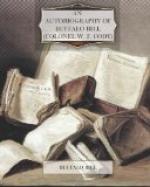Through their first sergeant they said they had followed Cody on many a long trail, and were willing to follow him to the end of this one. So the order to mount was given, and the trail was taken up. Several times that day we found the Indians had resorted to their old tactics of going in different directions. They split the herd of horses in bunches, and scattered them. It was very hard to trail them at good speed.
Forty hours without food, and twelve hours without water, we halted for a council when darkness set in.
I told Thomas that when we got within three miles of the Springs the men could rest their horses and get a little sleep, while I pushed on ahead to look for the Indians. This was done. When we reached the spot I had designated the saddles were removed, so that the horses could graze and roll. I rode on ahead.
As I had suspected I should, I found the Indians encamped at the Springs with the stock grazing around them. As quickly as possible I got back to the command with my news. The horses were quietly saddled and we proceeded, seldom speaking or making any noise.
As we rode along I gave the lieutenant and first sergeant the description of the camp and suggested that it could be best approached just at daylight. We had but forty-one men. Ten of these, I said, should be detailed to take charge of the herd, while the lieutenant and I charged the camp.
The Indians were encamped on a little knoll, around which was miry ground, making a cavalry charge difficult. The Indians numbered as many as we did. The safest plan was to dismount some of the men, leaving others to hold the horses, and proceed to the attack on foot. The rest of the men were to remain with their horses, and get through, the marshy ground mounted, if they could.
A halt was called, and this was explained to the men. It didn’t take them long to understand. We approached very cautiously till we got within a quarter of a mile of the Indians. Then the charge was sounded. We did not find the land as miry as we had supposed. Dashing in among the Indians, we completely surprised them. Most of them grabbed the guns, with which they always slept, and fled to the marsh below the camp. Others ran for their horses. It was fortunate that we had dismounted ten men. These were able to follow the Indians who had escaped to marsh.
When we made the charge my chief thought was to keep a lookout for my pony, Powder Pace. Soon I saw an Indian, mounted on him, making his escape. I rushed through the camp, shooting to the left and right, but keeping a beeline after Powder Face and his rider. Soon another Indian who was afoot leaped up behind Powder Face’s rider. I knew that the little animal was very swift for a short distance, but that he would be badly handicapped by the weight of two men.
I realized that my old Buckskin Joe was tired but his staying qualities were such that I was sure he would overtake Powder Face, carrying double weight.




